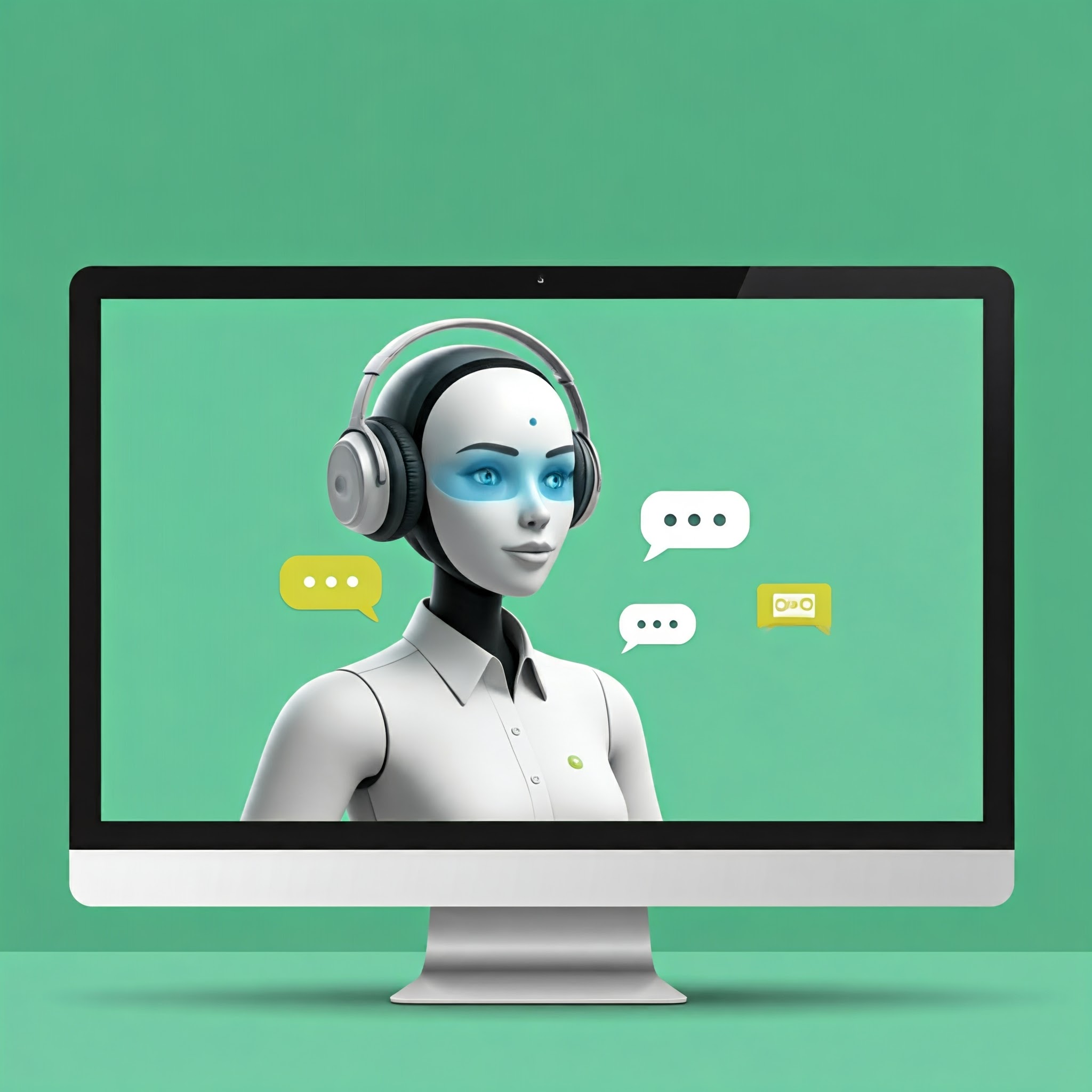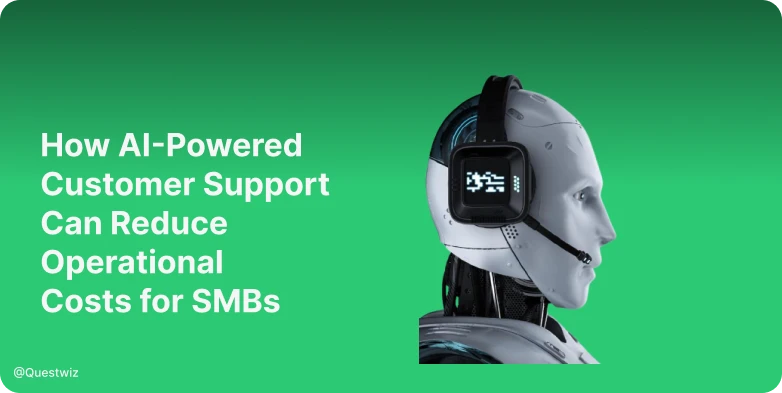Best Practices for Implementing AI Chatbots for SMBs
Learn how SMBs can improve customer support with AI chatbots. Discover 5 best practices for implementation, from planning to enhancing customer experience.
by QuestWiz Team
Published On:
Sep 26, 2024

Efficient customer support might be an uphill challenge for many small or medium-sized businesses. The challenge often increases when SMBs owners have to deal with lots of inquiries with not enough staff to answer in a timely and personalized fashion, consequently resulting in overall poor customer support. Little wonder about 70% of SMB owners fail before their 10th year of operating.
Implementing AI chatbots for customer service will help create a world where customer inquiries are instantly solved, with personalized support and significant reduction of tasks on the human support team, giving them the much-needed drive to scale the business. Studies have shown that interactive AI Chatbots have improved customer service agents' productivity by 94%, reduced response time by 92%, and minimized customer service effort by 87%.
As you read on, this guide will focus on the best practices for helping SMBs integrate and enhance the productivity of AI chatbots to augment the performance of their customer service team in providing better levels of customer support.
5 Best Practices for Implementing AI Chatbots for SMBs
Planning and Preparation
Implementing an effective custom AI chatbot for customer service starts with careful planning. The first thing to do is to create a flowchart outlining customer interactions to identify loopholes. If you do not have well-defined goals and a good understanding of your customer, the most advanced chatbot can still be inefficient. Also, reduced response time, handling FAQs(frequently asked questions), and the overall improvement of customer satisfaction should be established.
So, how do you go about planning and preparation? It is simple!
Gathering data: Data provides information on what needs to be salvaged regarding customer service, helping enhance service quality and strengthen customer relationships. Customers also complain about the frustration of dealing with multiple agents. AI can be trusted to eliminate every chance of repeated complaints.
Let's explore an instance:
Customer: I have had it with the delays. I ordered a lamp on the 1st of this month, to be delivered on the 3rd but after several emails and calls later, I am still being tossed around between agents with no idea where my lamp is. I just need my lamp or my money back.
Naturally, this would set any human agent off even if they are trying to help. However, AI chatbots are designed to understand such scenarios and make sure customer satisfaction is achieved. This personalization technique will surely ingrain the customer’s trust and loyalty to your brand.
Choosing the right Chatbot Platform: Choosing platforms involves selecting the right tool that captures your brand’s needs for the AI chatbots. To achieve this, search for features like ease of integration with your existing systems, scalability, and user-friendly design tools. Software like CRM, helpdesk tools, and other communication channels are fused to work with your chatbot to handle customers’ requests effectively.
Visualize this scenario:
Customer: I ordered the steel stick hooks and the raffia flower pot designs, but unfortunately the item is damaged. I was looking forward to using it. Can you help me with an exchange?
AI Chatbot: Hello! I am sorry you received a damaged item. That’s certainly not the experience we aim to provide our customers. Kindly provide your order number and a description of the item. I can help process a return or exchange for a perfect item. I am here to help make this process as smooth as possible!
Establishing a formidable foundation through meticulous planning and preparation sets the pace for an AI chatbot that will transform your customer service operations.
Designing the Chatbot
It is common knowledge that modern AI chatbots rely on Natural Language Processing (NLP) to enhance their functionality and improve user interactions. This advanced feature helps eradicate generic tone in responding to your customers queries. The AI chatbot has to be accustomed to your brand through the process of interaction with the customer. Oftentimes, customers complain about the lack of empathy during a session with an agent, rude or frustrated replies including abandonment during a chat. These are issues that will be unknown to a brand with a well-designed AI chatbot.
To adequately achieve this, you must start by identifying the use case of AI chatbots and designing Natural Language Processing to match your brand voice. Train the AI Chatbot to process its language program to sound human-like.
This is what Natural Language Processing (NLP) is all about: simple, understandable human-tone responses.
Here are some scenarios for insight:
Product Recommendation
Case 1: A customer is surfing for a gift but is confused about what to choose.
Tone: Helpful and energetic
AI Chatbot: Are you looking for the perfect gift for your wife? I’d love to help! What’s the occasion though? I have suggestions varying from sparkly pieces of jewelry to a tesla.
Following Up After a Purchase
Case 2: A customer has just ordered a shoe rack.
Tone: Friendly and engaging
AI Chatbot: Thanks for your recent order from…! (insert emoji) I hope you’re excited about your package. If you need further assistance do not hesitate, I’m just a d.m away! (emoji)
These two cases show the improvement in AI's friendly personality and helpful tone which will help customers fully explore their requests and find lasting solutions. For example, for a customer that needs to return a product. Prepare visual representations (videos showing steps on how to return a damaged product), icons to represent key steps to take, and feedback mechanisms (forms to fill out to gather data about their experience).
Intuitive user flows are organized steps designed to map the user journey for smooth navigation through the chatbot interface. AI chatbots with perfect NLP will interact with customers on a human level with high emotional intelligence to drive sales and foster a quality relationship between the customer and the AI chatbot.
Implementing Strategies for the Pilot Initiative
The pilot stage is critical to prod, prompt, and provoke your AI chatbot to do what you have planned for and designed your chatbot to do. Many SMBs base their strategies and plans on what they believe will work for them because it worked for someone and that is how a business dies a first death.
Your AI chatbot must be tested to allow room for refining and realignment, so start mapping out common goals you want to achieve with your AI chatbot. Generally, the common goals to achieve in this pilot phase with customer service include reduced response time, handling FAQs, and improved overall customer satisfaction. So you must:
Set roles and responsibilities for each team, especially the IT staff, customer service teams, and chatbot software developers. This ensures a clear plan to help coordinate efforts and carefully organize the development, testing, and development phases.
Choose your target audience to test the performance of the AI Chatbot, and gather feedback, particularly the chatbot’s impact on customer interactions.
Use existing CRM tools to foster integration and compatibility with your AI Chatbot to obtain customer data and deliver personalized experiences.
Your agents must be trained to get familiar with the interface, test the abilities of the AI Chatbot, and rate their experience. This will give room for escalation of any issues faced and how to troubleshoot. Only well-trained staff should be allowed the chance to handle real customer interactions.
Key Points:
Assigned Roles: Each department will be assigned roles to achieve coordinated efforts and progressive development, for seamless software testing, and development phases.
Personalization: AI Chatbot will gather user information from the customer to deliver timely help if any issue escalates.
AI Chatbot performance in terms of response time, resolution rates, and customer satisfaction scores will be evaluated using analytical tools (e.g, CallMiner). Use feedback from customers and staff about their experience, to identify areas for improvement.
Monitoring AI chatbot Improvement
SMB owners venture into businesses because it is considered small and they underestimate the dangers of neglecting issues as they freshly occur and this is why businesses are irredeemable in the end. If you want to maintain what you’ve achieved so far, closely monitor the performance of your AI Chatbot. Don’t be a part of the 70% with dead SMBs. While it is good to celebrate the little success you achieve at the pilot stage you still need to keep track of the consistency using analytics to track the chatbot interactions, response times, and user satisfaction.
Keep close tabs on customer feedback to keep you abreast of their experiences and enhancements. Customized Google Forms will help you gather data. Also, keep track of letters, reviews on your website, and comments on social media.
Set up team meetings to share new information with your staff and provide timely software updates for your AI Chatbot. Always be one step ahead because your AI Chatbot has to stay relevant.
A/B tests help optimize AI Chatbots in customer service by comparing two versions of chatbots to establish which one yields better performance and customer satisfaction results. You can effectively run an A/B test for a space of two weeks.
Key Point:
Note in detail every form of complaint and unsatisfactory experience from customers. This will give room for improvement, put you one step ahead of the situation, and secure a personalized customer experience.
Enhancing User Experience
Personalization is achieved by implementing information gained from customer data into the AI Chatbot NLP program. You want to convince your customer to fully trust that your AI Chatbot listens, understands, and offers lasting solutions to their needs. Your customer needs to feel connected to the brand and creating a custom AI chatbot is not only intriguing, it's also life-changing.
Here are a few tips to enhance your user experience:
Proactive engagement is about being one step ahead, learning their possible queries, and having hands-on solutions. Set up your AI Chatbot to proactively offer assistance based on user behavior reflected in browsing patterns, purchase history, or engagement on the page.
To avoid unresolved issues, the AI Chatbot will follow up on customer’s inquiries to guarantee satisfaction. This will prevent unresolved or recurring issues, but sometimes, additional help is needed from human agents.
To provide smooth and consistent service, offer multichannel support via websites, mobile apps, social media, or messaging apps.
Elevate Your Customer Support Strategy by Creating Custom AI Chatbots
To achieve success in your business, you should know that customer support constitutes an integral part of your strategy- this is where AI chatbots come in handy. The best practices for implementing AI chatbots for SMBs start with understanding the set goals and how to achieve them through planning and preparation.
Ensure that your AI Chatbot’s personality, tone, and style are modified to enhance human-like interactions with the user. Learn to personalize the needs of your customer through their interaction with the AI Chatbot.
Design your custom AI chatbot to recognize complex queries and transfer them to human agents when necessary. Efficient escalation processes ensure customers receive appropriate support without frustration.
Whether you choose to create a chatbot for customer support or use a platform like Questwiz that allows users to create their custom chatbots seamlessly, the benefits are significant for SMBs.

